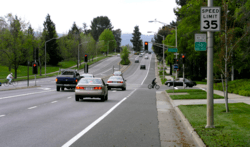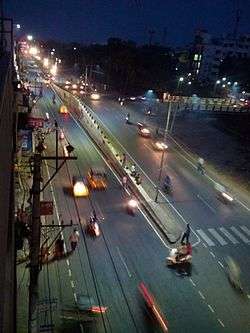Arterial road


An arterial road or arterial thoroughfare is a high-capacity urban road. The primary function of an arterial road is to deliver traffic from collector roads to freeways or expressways, and between urban centres at the highest level of service possible. As such, many arteries are limited-access roads, or feature restrictions on private access.
Though the design of arterial roads varies from country to country, city to city, and even within cities, they share a number of common design characteristics. For example, in many cities, arteries are arranged in concentric circles (commonly referred to as ring roads) or in a grid. Many jurisdictions also classify arterial roads as either principal (major) or minor.
In traffic engineering hierarchy, an arterial road delivers traffic between collector roads and freeways. For new arterial roads, intersections are often reduced to increase traffic flow. In California, arterial roads are usually spaced every half mile, and have intersecting collector(s) and streets. Some arterial roads, characterized by a small fraction of intersections and driveways compared to most arterial roads, are also considered to be expressways in some countries and some states of the United States.
Definition
The Traffic Engineering Handbook describes "Arterials" as being either principal or minor. Both classes serve to carry longer-distance flows between important centers of activity. Arterials are laid out as the backbone of a traffic network and should be designed to afford the highest level of service, as is practical, as per the aforementioned "Traffic Engineering Handbook".[1]
Development
The construction and development of arterial roads is achieved through two methods. By far the most common is the upgrading of an existing right-of-way during subdivision development. When existing structures prohibit the widening of an existing road however, bypasses are often constructed. Because of the placement and general continuity of arterial road corridors, sewers, water mains, conduits and other infrastructure are placed beneath or beside the roadbed.
Specifications
In North America, traffic signals are used at most intersections (except where the intersecting road is a minor side street, in which case a stop sign is used instead). In Europe, large roundabouts are more commonly seen at the busier junctions. Speed limits are typically between 30 and 50 mph (50 and 80 km/h), depending on the density of use of the surrounding development. In school zones, speeds may be further reduced; likewise, in sparsely developed or rural areas, speeds may be increased.
The width of arterial roads can range from four lanes to ten or more. Some are divided at the center, while others share a common center lane, such as a contraflow lane or central turning lane.
Environmental issues
As with other roadway types, environmental consequences derive from arterial roadways, including air pollution generation, noise pollution and surface runoff of water pollutants. Air pollution generation from arterials can be rather concentrated, since traffic volumes can be relatively high, and traffic operating speeds are often low to moderate.[2] Sound levels can also be considerable due to moderately high traffic volumes characteristic of arterials, and also due to considerable braking and acceleration that often occur on arterials that are heavily signalized.[3]
See also
| Look up arterial road in Wiktionary, the free dictionary. |
References
- ↑ Neuman, Timothy R (1992). "Roadway Geometric Design". In Institute of Traffic Engineers. Traffic Engineering Handbook. Prentice Hall. p. 155. ISBN 0-13-926791-3.
- ↑ Roadway air dispersion model: U.S. Environmental Protection Agency
- ↑ C.Michael Hogan, Analysis of highway noise, Journal of Water, Air, & Soil Pollution, Volume 2, Number 3, Biomedical and Life Sciences and Earth and Environmental Science Issue, Pages 387-392, September, 1973, Springer Verlag, Netherlands ISSN 0049-6979
